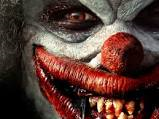
"Send in the Clowns" is a song written by Stephen Sondheim for the 1973 musical A Little Night Music, an adaptation of Ingmar Bergman's film Smiles of a Summer Night. It is a ballad from Act II in which the character Desirée reflects on the ironies and disappointments of her life.
The "clowns" in the title do not refer to circus clowns. Instead, they symbolize fools, as Sondheim explained in a 1990 interview: From <https://en.wikipedia.org/wiki/Send_in_the_Clowns> For those of you who remember back that far - Judy Collins... This song is for those of us who need to wake up and tell our young ones not to fear.... https://www.youtube.com/watch?v=8L6KGuTr9TI
There’s a word - albeit one not recognized by the Oxford English Dictionary or any psychology manual - for the excessive fear of clowns: Coulrophobia.
Clown costumes tend to exaggerate the facial features and some body parts, such as hands and feet and noses. This can be read as monstrous or deformed as easily as it can be read as comical. The significant aberrations in a clown's face may alter a person's appearance so much that it enters the so-called uncanny valley—in which a figure is lifelike enough to be disturbing, but not realistic enough to be pleasant—and thus frightens a child so much that they carry this phobia throughout their adult life From <https://en.wikipedia.org/wiki/Coulrophobia>
The clown has always been the fool, the jester, the buffoon, the comedian. At one time the buffoonery was used to conceal great wit and wisdom. The clown has also been a symbol of our cultural dark sides.
...But clowns have always had a dark side, says David Kiser, director of talent for Ringling Bros. and Barnum & Bailey Circus. After all, these were characters who reflected a funhouse mirror back on society; academics note that their comedy was often derived from their voracious appetites for food, sex, and drink, and their manic behavior. “So in one way, the clown has always been an impish spirit… as he’s kind of grown up, he’s always been about fun, but part of that fun has been a bit of mischief,” says Kiser. From <http://www.smithsonianmag.com/arts-culture/the-history-and-psychology-of-clowns-being-scary-20394516/?no-ist>
The "clown" character develops out of the zanni "rustic fool" characters of the early modern Commedia dell'arte, which were themselves directly based on the "rustic fool" characters of ancient Greek and Roman theatre. Rustic buffoon characters in Classical Greek theater were known as sklêro-paiktês (from paizein "to play (like a child)") or deikeliktas, besides other generic terms for "rustic" or "peasant". In Roman theater, a term for clown was fossor, literally "digger; labourer
Interesting fun fact:
One of the earliest uses of the word “Clown” occurs in one of Shakespeare’s plays. Everyone knows and misquotes, Hamlet’s speech, “Alas poor Yorick…” – fewer realise that the gravedigger who so casually passes the relic to Hamlet is, in the play, designated “Clown”.
From <https://www.clownbluey.co.uk/more-info/clown-history>
Then we have the whole abduction/screen memory complex where people are implanted with clowns, or owls or other such images over a real image as a way to confuse the actual memory of an alien interaction and de-intensify an alien appearance by replacing it with one of like shape and symbology making it harder to crack through to the actual memory.
Screen Memories, Stealth Encounters http://www.crystalinks.com/screenmemories.html
Which is where IMO the most recent 'fear of clowns has come from - that and some pre-conditioning in the scary clown movies of the 80' and 90's
Scary Clowns:
01- Stephen King's It (1990) (Tim Curry as Pennywise the Clown) ...
02- Amusement (2008) ...
03- Killer Klowns from Outer Space (1988) ...
04- Clownhouse (1989) ...
05- Blood Harvest (1987) ...
06- Poltergeist (1982) ...
07- Carnival of Souls (1998)
Which brings me around to the point of this article, Cultural Engineering.
“Cultural engineering is a conceptual approach to cultural development planning and management that takes into account the changing concepts of culture and the design of practical strategies for dealing with issues and problems raised by culture and development in diverse contexts….Mar 10, 2009 From <https://www.google.com/?gws_rd=ssl>
However, I am looking at this in a much darker context, in a very convoluted way. It is well known to us that haunt the conspiracy theories that the amount of cultural conditioning being promulgated upon us today is so great as to be bordering on ludicrous. So why shouldn't this little piece of 'Clown-Mania' be used in much the same way on a younger generation? Our tween and teens who then filter it down to our littles?? And... and I wasn't going to go here but... There is the incredibly rich loosh factor of the pure fear of a child to consider here...
As we are being kept in a mildly upsetting cage of idiocy like def-con3 and the impending election of - wait for it - clowns, in a world of false flags and bread and circus, why then wouldn't we expect them to go after the younger set too? Because the current clown scare, IMO, is nothing more that a calculated spread of FEAR PORN FOR KIDS!
INDOCTRINATE THEM EARLY!
TEACH THEM THE RIGHT WAY TO FEAR!!
PUT THIS CRAP ON SOCIAL MEDIA!!
And also - make it so stupid that no adult will listen or take it seriously...
But my god! Train them early, get them ready to accept the bigger lies that will be trotted out before them as they become young adults - teach them fear so that they will obey TPTB!
Cultural engineering and social manipulation at its best…start 'em early!

Leave a Reply